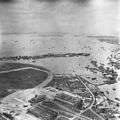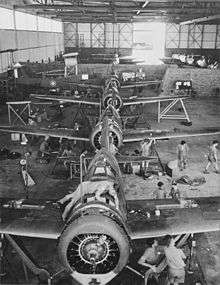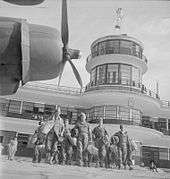Kallang Airport
| Kallang Airport Pangkalan Udara Kallang 加冷机场 (Jiā Lěng Jīchǎng) காலாங் வான்முகம் (Kālāṅ Vāṉmukam) | |||||||||||
|---|---|---|---|---|---|---|---|---|---|---|---|
|
The control tower of Kallang Airport | |||||||||||
| IATA: N/A – ICAO: N/A | |||||||||||
| Summary | |||||||||||
| Airport type | Civilian public usage | ||||||||||
| Operator | Ceased operating 1955 | ||||||||||
| Serves | Singapore | ||||||||||
| Location | Kallang | ||||||||||
| Coordinates | 01°18′26.68″N 103°52′24.16″E / 1.3074111°N 103.8733778°E | ||||||||||
| Runways | |||||||||||
| |||||||||||
The Kallang Airport also known as the Kallang Aerodrome, Kallang Airfield and RAF Kallang, opened in 1937 as Singapore's first purpose-built civil airport, together with an anchorage for seaplanes. Land was reclaimed in the Kallang Basin to turn the swampy area into a circular-shaped airfield and to build a slipway for the seaplanes. The airport was closed in 1955 when the new Singapore International Airport at Paya Lebar was built. Although most of the airport was demolished and put to other use, the distinctive terminal building was used as the headquarters of the People's Association until April 2009. It is currently unoccupied.
History
Singapore's strategic location on the routes from Europe to the Far East, Australia, New Zealand and the Pacific Islands, traversing the Middle East and India, made it an ideal centre to serve the region in aviation. In 1930, the RAF-owned Seletar Airbase was opened to commercial aircraft.
On 11 February 1930, the Dutch Airline Koninklijke Luchtvaart Maatschappij (KLM) operated the first service flight between Amsterdam and Batavia (since renamed Jakarta), landing in Seletar with a Dutch-made Fokker trimotor monoplane carrying 8 passengers and a cargo of fresh fruit, flowers and mail. This marked the beginning of commercial civil aviation in Singapore. KLM later introduced a regular Amsterdam to Batavia flight service in late-1931.
Two years later, in July 1933, Imperial Airways, the flagship airline of the British empire at the time, started a service between London and Darwin via Cairo, Karachi, Calcutta, Singapore and Jakarta. This service was later extended to Brisbane and operated jointly with Qantas Empire Airways on 17 December 1934.
Booming commercial aviation traffic led to congestion at the existing Seletar Airbase (today's Seletar Airport), creating a need for a new airport. On 31 August 1931, Sir Cecil Clementi, then Governor of the Straits Settlements, announced that Kallang Basin would be the location for the new civil aerodrome suitable for land planes and seaplanes, and relieving Seletar of commercial flight activities.
Looking into the future, I expect to see Singapore become one of the largest and most important airports of the world ... It is, therefore, essential that we should have here, close to the heart of the town, an aerodrome which is equally suitable for land planes and for sea planes; and the best site, beyond all question, is the Kallang Basin.
Sir Cecil Clementi, Governor of the Straits Settlements,[1] 31 August 1931.
Construction
Reclamation work began on the 103 hectares of tidal swamp in Kallang Basin in 1932. Seven million cubic metres of earth were used for the filling of this tidal swamp. By 1936, all reclamation and consolidation of land were completed, forming a 915-metre diameter, dome-shaped landing ground.
On 12 June 1937, the Kallang Aerodrome was officially opened by Sir Shenton Thomas, who had taken over the governorship of the Straits Settlements from Sir Cecil in 1934. At the time it was hailed as "the finest airport in the British Empire", with facilities that were considered revolutionary. The circular aerodrome allowed planes to land from any direction, and the slipway allowed seaplanes to be served at the same terminal building as regular planes. The terminal building itself was considered a marvel, with a large open-air viewing gallery on the top of the two-storey building and a circular control tower in the middle of the glass-covered building.
World War II
When the Japanese launched their invasion of Malaya and Singapore on 8 December 1941, Kallang was the principal fighter airfield. By January 1942, it was the only operational fighter airfield in Singapore, as the other airfields (Tengah, Seletar and Sembawang) were within range of Japanese artillery at Johore Bahru.
Brewster Buffalo fighters of 243 Squadron RAF, 488 Squadron RNZAF and a detachment of 2-VLG-V of the Royal Netherlands East Indies Air Force operated from the airfield, defending Singapore from repeated Japanese air raids. They were joined later by Hawker Hurricanes of 232 Squadron RAF, but attrition took a steady toll on men and machines, and by the last days of January 1942, the airfield had been badly damaged by the bombing and only a small number of aircraft were serviceable. The last of the fighters left in early February, escaping to carry on the fight just before Singapore was surrendered to the advancing Japanese.
The war years and after
The growth in aviation traffic was stunted during the war years, a period which saw the landing circle being converted into a single runway to allow use by warplanes. The British Overseas Airways Corporation (BOAC) and Qantas resumed their regular services to the airport, while the resurrected local airline Malayan Airways (MAL) began services on 1 May 1947.
In the early 1950s, the increasing size of aircraft and the need for longer runways resulted in it being extended beyond Mountbatten Road in the eastern boundary of the facility into what is now Old Airport Road. This necessitated the installation of traffic lights to halt vehicular traffic every time a plane took off or landed.
Closure
The success of Malayan Airways and rapid growth again caused congestion at the facility, while advancing technology necessitated extension of the only runway. This was no longer possible because of residential areas in the way, leading to a decision to build a new facility at Paya Lebar in 1951, 8 km further from the city. When the new airport was completed on 20 August 1955, Kallang Airport was closed down, and all associated facilities moved to the new facility. The runway was converted into a road, and the airfield turned into a recreational area with the building of the National Stadium (now reopened as Singapore Sports Hub)and Singapore Indoor Stadium.
Photo gallery
 1945 aerial photo of Kallang Airport's runway
1945 aerial photo of Kallang Airport's runway 1945 aerial photo of Kallang Airport runway and ramp, as well as Kallang Basin area
1945 aerial photo of Kallang Airport runway and ramp, as well as Kallang Basin area 1945 aerial photo of Kallang Airport runway, ramp and terminal building, as well as Kallang Basin area
1945 aerial photo of Kallang Airport runway, ramp and terminal building, as well as Kallang Basin area Brewster Buffalo Mark Is being re-assembled inside a hangar at Kallang in March 1941.
Brewster Buffalo Mark Is being re-assembled inside a hangar at Kallang in March 1941. A row of Japanese Kawasaki Ki-45 fighters captured at Kallang airfield during the liberation of Singapore.
A row of Japanese Kawasaki Ki-45 fighters captured at Kallang airfield during the liberation of Singapore. The first British prisoners of war to be evacuated from Singapore after liberation walk to their aircraft at Kallang airport.
The first British prisoners of war to be evacuated from Singapore after liberation walk to their aircraft at Kallang airport. Royal Air Force personnel pass in front of a B-24 Liberator aircraft at Kallang airport, Singapore, in 1945-46.
Royal Air Force personnel pass in front of a B-24 Liberator aircraft at Kallang airport, Singapore, in 1945-46.
Accidents and incidents
- On 29 June 1946, one of the Dakota aircraft belonging to the Royal Air Force Police with 20 NCOs on board crashed at the Airport in a storm with no survivors. The nearby Dakota Crescent and the Dakota MRT Station are named in commemoration of this disaster.[2]
- On 13 March 1954, a BOAC Lockheed Constellation, G-ALAM Belfast carrying mail crashed while attempting to land at Kallang Airport en route to London from Sydney. The accident killed 32 people, including eight crew.[3]
Legacy
Kallang Airport has left several reminders of its existence. The old runway, near to Mountbatten Road, is now called Old Airport Road. The surrounding public flats there are named the Old Kallang Airport Estate. The estate is served by Dakota MRT Station, which took its name from the Dakota DC-3 aircraft which used to land at the Kallang Airport.
Two new roads near Kallang MRT Station have been named "Kallang Airport Drive" and "Kallang Airport Way". In addition, Old Terminal Lane, which links Geylang Road with Kallang Airport Way, references the Kallang Airport's conserved terminal building.
The slipway for seaplanes was occupied by the Oasis Building, a structure built on the Kallang Basin. The terminal building itself was used as the headquarters of the People's Association until 9 April 2009, when it moved to its new headquarters at King George's Avenue.
Kallang Airport was gazetted for conservation on 5 December 2008 by the Urban Redevelopment Authority (URA) of Singapore.
See also
References
- ↑ "Ho, L.H., Flight Into Fantasy: Singapore's journey into Aviation. AirLine Pilots Association, Singapore"
- ↑ A Concise History of the Royal Air Force Police, http://www.rafpa.com/history.htm)
- ↑ The Straits Times 14 March 1954.